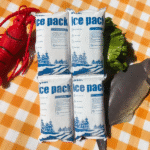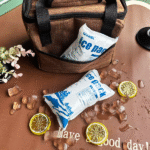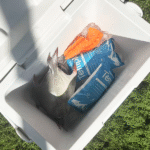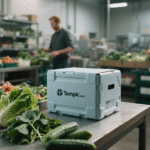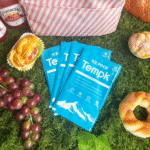Cold chain management in the pharmaceutical industry protects the integrity and safety of temperature sensitive medicines. As biologics and advanced therapies gain prominence, billions of dollars ride on maintaining stable conditions. في 2024 the global pharmaceutical cold chain logistics market was valued at about US $18.6 billion with projections to reach US $27.1 billion by 2033. The sector continues to expand alongside demand for vaccines, gene therapies and personalized medicines. في 2025, you must not only keep products within the 2-8 درجة مئوية range but also comply with evolving regulations, adopt smart technologies and embrace sustainability. This article breaks down everything you need to know.
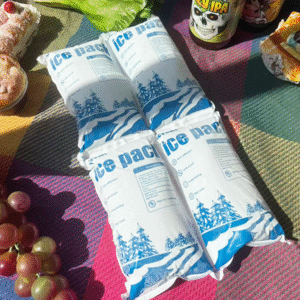
What are the fundamentals of cold chain management in the pharmaceutical industry? – including temperature ranges, monitoring and packaging requirements.
How do regulatory frameworks and compliance shape cold chain strategies? – covering Good Distribution Practices (الناتج المحلي الإجمالي), FDA and EMA expectations and documentation rules.
Which technologies are transforming pharmaceutical cold chains in 2025? – exploring IoT sensors, تحسين مسار الذكاء الاصطناعي, إمكانية تتبع blockchain, automation and cryogenic solutions.
Why is sustainability becoming essential in cold chain logistics? – highlighting energy efficient refrigeration, solar storage and eco friendly packaging.
What market trends and growth indicators matter for planners? – summarising market sizes, CAGR, regional dynamics and growth drivers.
How can you address common challenges and temperature excursions? – outlining best practices, training and contingency planning.
What are the latest developments and trends in 2025? – listing emerging innovations and regulatory updates.
What Are the Fundamentals of Cold Chain Management in the Pharmaceutical Industry?
Cold chain management ensures that pharmaceuticals stay within their approved temperature range from manufacture to administration. Temperature sensitive products such as vaccines, البيولوجيا, cell therapies and insulin must be kept cold or frozen to preserve potency and prevent contamination. A dedicated logistics process encompassing temperature controlled storage, مواصلات, packaging and continuous monitoring is therefore essential. Small deviations can cause irreversible damage and render medicines ineffective.
Why is Temperature Control Critical?
Medicines have strict stability profiles. تتطلب العديد من اللقاحات والمستحضرات البيولوجية تخزينها بين 2-8 درجة مئوية (36–46 °F), referred to as the 2–8 °C cold chain. Others need to be frozen at -20 درجة مئوية or kept below -70 درجة مئوية for ultra low temperature products like mRNA vaccines. Breaching these ranges – a temperature excursion – can compromise product efficacy, jeopardising patient safety and causing costly recalls. The World Health Organization notes that عن 20% of temperature sensitive health products are damaged during distribution due to poor cold chain management.
Core Elements of Effective Cold Chain Management
To maintain integrity throughout the supply chain, your cold chain program should include:
Accurate temperature maintenance: Keep products within their validated range. For pharmaceuticals this often means 2–8 °C for refrigerated goods, –20 °C for standard freezing and below –70 °C for ultra low storage.
24/7 يراقب: Use automated data loggers and IoT sensors to track temperature, الرطوبة والموقع بشكل مستمر. Real time alerts allow immediate intervention when deviations occur.
البنية التحتية المعتمدة: Employ certified refrigeration units, insulated vehicles and temperature controlled packaging that consistently meet regulatory standards.
Specialist packaging: Utilise thermal packaging materials such as gel packs, مواد تغيير المرحلة (PCMS) and vacuum insulated panels to maintain stable conditions in transit.
Detailed record keeping: Maintain documentation for temperature logs, equipment calibration, personnel training and deviation handling.
Contingency plans: Prepare protocols to respond to equipment failure, power outages or delays. This includes emergency storage options and product quarantine procedures.
Trained personnel: Everyone handling cold chain products should understand proper loading/unloading, monitoring device operation and corrective actions.
Temperature Ranges and Their Applications
| Range Category | درجة حرارة | منتجات المثال | معنى لك |
| مبردة (مبردة) | 2-8 درجة مئوية | Common vaccines, الأنسولين, الأجسام المضادة أحادية النسيلة | Standard range requiring continuous monitoring. Ensure packaging can maintain 2–8 °C during transit and storage. |
| المجمدة | -20 درجة مئوية | Some plasma products, specific vaccines | Requires specialised freezers and packaging to prevent ice formation. |
| منخفض جدًا / المبردة | –70 °C or lower | لقاحات مرنا, العلاجات الجينية والخلايا | Necessitates dry ice or liquid nitrogen dewars; high risk of excursions; real time temperature tracking is critical. |
| Ambient Controlled | 15-25 درجة مئوية | Tablets, capsules, بيولوجية معينة | Still needs temperature control in hot climates; benefits from thermal insulation and data logging. |
Practical Tips for You
رسم خريطة لسلسلة التوريد الخاصة بك: Identify the weakest links—from manufacturer to last mile distribution—and implement monitoring devices at each stage.
Invest in modular packaging: Use reusable insulated containers with PCMs tailored to your product’s temperature range. Testing them under real world conditions reduces the risk of excursions.
Conduct stability studies: Validate how long your product can withstand short excursions and adjust SOPs accordingly. Regulatory bodies expect documented excursion impact studies.
Use performance metrics: Track key indicators such as temperature excursion frequency, device calibration compliance and staff training completion to continuously improve your cold chain.
مثال الحالة: خلال طرح لقاح كوفيد 19, Pfizer used GPS enabled thermal shippers and replenished dry ice during transit to maintain –70 °C conditions, ensuring the vaccines remained potent.
How Do Regulatory Frameworks and Compliance Shape Pharmaceutical Cold Chain Strategies?
Regulatory compliance is non negotiable in pharmaceutical logistics. Authorities such as the نحن. إدارة الغذاء والدواء (FDA), وكالة الأدوية الأوروبية (ema) و منظمة الصحة العالمية (من) provide frameworks to ensure medicines remain safe and effective. في 2025 these bodies are tightening requirements and increasing inspections.
Understanding Good Distribution Practices (الناتج المحلي الإجمالي)
ممارسات التوزيع الجيدة are international standards governing the storage and distribution of medicinal products. They cover facility management, route qualification, مراقبة درجة الحرارة, supplier audits and documentation. The EU GDP guidelines (2013/ج 343/01) and Directive 2001/83/EC specify how medicines and active substances should be handled across the supply chain. Compliance ensures products maintain identity, strength and purity until they reach the patient.
Key principles include:
Quality system: Documented processes, quality risk management and internal audits to demonstrate continuous control.
Responsible person: A qualified individual responsible for ensuring GDP compliance, including oversight of outsourced activities.
Temperature mapping and qualification: Warehouses and routes must be mapped to identify hot/cold spots and equipped with validated monitoring systems.
Computerised systems: Data integrity and traceability must be ensured through validated electronic systems with audit trails.
Management of returns and recalls: Procedures must exist for investigating complaints, handling recalls and preventing re introduction of non conforming products.
Regulatory Landscape by Region
| Regulatory Body | نِطَاق | المتطلبات الرئيسية | المعنى العملي |
| FDA (نحن.) | Applies to pharmaceuticals distributed in the United States | Mandates validated storage and transportation systems capable of maintaining temperature integrity. Requires robust documentation and reporting. | Implement continuous monitoring and ensure your infrastructure is validated. Prepare for audits and maintain full traceability. |
| ema (الاتحاد الأوروبي) | Governs medicinal products within the EU/EEA | GDP guidelines require structured impact assessments for temperature excursions and documented responses. Regulatory updates may end blanket extensions of GDP certificates and emphasise on site inspections. | Conduct regular self inspections and maintain updated certifications. Stay informed on policy changes. |
| من | Provides international best practices | Model GDP emphasises continuous monitoring, Corrective and Preventive Actions (CAPA), and stability data. | Adopt risk based approaches and CAPA programs to address excursions. |
| الناتج المحلي الإجمالي للاتحاد الأوروبي (2013/ج 343/01) | Applies to wholesalers and logistics operators | Specifies facility requirements, route qualification, مراقبة درجة الحرارة, supplier auditing and documentation. | Ensure your partners are audited and qualified. Document every step from purchase to export. |
Consequences of Non Compliance
A broken cold chain can lead to product degradation, public health risks, الخسائر المالية, regulatory action and reputational damage. Regulatory bodies can impose heavy fines, force product recalls or suspend licences. To avoid these outcomes, يجب عليك:
Implement a quality management system (نظام إدارة الجودة) aligned with GDP and GMP.
Train your workforce regularly on handling procedures and emergency protocols.
Audit your suppliers and third party logistics providers for compliance.
Document excursions and CAPA actions to demonstrate control and continuous improvement.
التحقق من الواقع: في وقت مبكر 2025, the EMA announced that automatic extensions of GDP certificates would no longer be granted, signalling a return to regular on site inspections. Companies operating in Europe should therefore ensure their documentation and facilities are inspection ready.
Which Technologies Are Transforming the Pharmaceutical Cold Chain in 2025?
Technological innovation is reshaping how temperature sensitive medicines are stored, transported and monitored. Digital tools enable real time visibility, predictive analytics and enhanced security. Integrating these technologies into your cold chain can reduce waste, improve compliance and increase efficiency.
أجهزة استشعار إنترنت الأشياء والمراقبة في الوقت الحقيقي
IoT devices collect temperature, humidity and location data in real time, sending alerts when conditions deviate. Lascar Electronics emphasises that 24/7 monitoring is a core requirement for compliance. IoT sensors with GPS functionality enable real time position tracking and immediate notifications. Active sensors reduce operational risks and protect products during transit by enabling quick corrective action.
فوائد:
Prevent spoilage: Instant alerts help avoid temperature excursions and product loss.
Improve compliance: Continuous data provides proof of adherence to GDP and FDA guidelines.
Enhance transparency: Stakeholders can access real time dashboards to track shipments.
الذكاء الاصطناعي والتحليلات التنبؤية
AI analyzes large data sets from IoT sensors to optimise routes, predict equipment failures and prevent excursions. AI powered route optimisation combines traffic and weather data to ensure prompt delivery of temperature sensitive products. Predictive analytics can identify upcoming temperature deviations and trigger early alerts. AI also supports maintenance by detecting patterns that signal equipment failure.
Blockchain للتتبع
Blockchain creates an immutable ledger of temperature data, ensuring transparency and preventing tampering. PharmaNow explains that blockchain provides end to end traceability, recording every step of product transport and sharing data with stakeholders. This builds trust and aids regulatory compliance by demonstrating product integrity and chain of custody.
الأتمتة والروبوتات
أنظمة التخزين والاسترجاع الآلية (AS/RS) and robotic handling systems streamline warehouse operations. The industry faces labour shortages and rising labour costs, driving adoption of robotics. Automated systems operate continuously, reduce human error and improve consistency in temperature control.
Cryogenic and Portable Freezers
العلاجات الجينية والخلوية, as well as mRNA vaccines, require cryogenic logistics. تحافظ المجمدات المبردة المحمولة على درجات حرارة منخفضة تصل إلى –80 °C to –150 °C and offer real time temperature tracking. DataM Intelligence notes that the cryogenic segment will hold 31.45 ٪ of the pharmaceutical cold chain market in 2024. Companies like CSafe have introduced reusable dewars integrated with real time tracking to serve the cell and gene therapy market.
Sustainable and Smart Packaging
Sustainable packaging solutions such as biodegradable insulated containers, recyclable thermal wraps and reusable cold packs are gaining traction. Solar powered cold storage units reduce energy consumption and serve rural areas with unreliable electricity. The global shift toward sustainability also includes natural refrigerants and energy efficient refrigeration systems.
Comparing Technologies
| تكنولوجيا | وصف | الفوائد الرئيسية | معنى لك |
| مستشعرات إنترنت الأشياء | Connected devices measure temperature, الرطوبة والموقع. | Real time alerts, continuous data for compliance, improved transparency | Reduces excursions and supports audit readiness. |
| الذكاء الاصطناعي | Algorithms analyze data to optimize routes and predict risks. | Shorter delivery times, proactive maintenance and risk mitigation | Improves efficiency and reduces costs. |
| بلوكتشين | Distributed ledger records each transaction in the supply chain. | Tamper proof traceability, enhanced security and regulatory compliance | Builds trust and streamlines audits. |
| الأتمتة & الروبوتات | Automated storage and retrieval systems handle inventory without human intervention. | Faster throughput, reduced labour costs, التحكم في درجة الحرارة المتسق | Increases capacity and reduces errors. |
| Cryogenic Freezers | Portable or stationary units maintain –80 °C to –150 °C. | Enables transport of gene therapies and mRNA vaccines; تتبع في الوقت الحقيقي | Expands product portfolio and market reach. |
| عبوة مستدامة & Solar Power | Eco friendly materials and renewable energy solutions reduce carbon footprint. | Lower operating costs, الامتثال التنظيمي, تقليل النفايات | Aligns with corporate sustainability goals and consumer expectations. |
Tips for Implementation
Pilot new technology: Start with a pilot project to test performance before scaling.
دمج الأنظمة: Combine IoT, AI and blockchain for holistic visibility and predictive capabilities.
تدريب الموظفين: Introduce change management programs to ensure staff are comfortable with new tools.
Plan for data security: Protect sensitive data through encryption and access controls.
مثال العالم الحقيقي: في فبراير 2024 Sensitech introduced the TempTale GEO X device, an IoT temperature monitoring solution that delivers real time analytics for temperature sensitive medicines transported globally. Innovations like these demonstrate how technology can enhance compliance and efficiency.
Why Are Sustainable Practices and Packaging Becoming Essential?
The cold chain is energy intensive and historically reliant on refrigerants with high global warming potential. في 2025 environmental sustainability is both a regulatory requirement and a competitive differentiator. The global food cold chain accounts for around 2 % من انبعاثات ثاني أكسيد الكربون العالمية, highlighting the need for greener logistics.
Drivers of Sustainable Cold Chain
الضغط التنظيمي: Governments and agencies are tightening environmental regulations. على سبيل المثال, the UN Environment Programme pushes for energy efficient refrigeration and natural refrigerants.
توقعات المستهلك: Customers increasingly prefer eco friendly brands. Sustainable packaging and lower emissions can enhance brand loyalty.
وفورات في التكاليف: Solar powered cold storage units reduce energy costs, with commercial solar rates between 3.2–15.5 cents/kWh, offering substantial savings compared to the 13.1 cents/kWh average for commercial electricity in 2024.
Supply chain resilience: الممارسات المستدامة, such as reusable packaging and renewable energy, can mitigate disruptions during power outages or fuel shortages.
Green Solutions in Practice
| Sustainable Innovation | What It Does | فوائد لك |
| التخزين البارد بالطاقة الشمسية | Uses solar panels to power refrigeration units, particularly in regions with unreliable grids. | Cuts operating costs, reduces carbon footprint and enables cold chain access in remote areas. |
| قابلة للتحلل & التعبئة والتغليف القابلة لإعادة التدوير | حاويات قابلة لإعادة الاستخدام, recyclable thermal wraps and biodegradable insulation. | Minimises waste, meets regulatory requirements and aligns with corporate sustainability goals. |
| Natural Refrigerants & Energy Efficient Equipment | Replaces hydrofluorocarbons with low GWP gases; employs energy efficient compressors and insulation. | Reduces greenhouse gas emissions and improves energy efficiency. |
| Circular Programs | Encourages returning and reusing temperature controlled packaging. | Lowers material costs and waste while improving sustainability metrics. |
Practical Tips for You
إجراء تدقيق للطاقة: Identify inefficient equipment and opportunities for solar integration.
Engage suppliers: Partner with vendors who share sustainability goals and can provide recyclable or reusable packaging.
Calculate ROI: Compare upfront costs of solar or eco friendly packaging against long term savings to justify investments.
تثقيف العملاء: Communicate your sustainability efforts to build trust and differentiate your brand.
How Are Market Trends and Growth Indicators Shaping Cold Chain Management?
The pharmaceutical cold chain is growing rapidly. DataM Intelligence estimates that the market reached US $18.61 billion in 2024 and will grow to US $27.11 billion by 2033 في أ 4.3 % CAGR. The overall cold chain logistics market (عبر الطعام, pharma and other sectors) تم تقديره نحن $436.30 مليار في 2025 ومن المتوقع أن يصل نحن $1,359.78 مليار من قبل 2034, expanding at a 13.46 % CAGR.
محركات النمو
Rise of biologics and gene therapies: Biologics account for roughly 30 % of all drugs and require strict cold chain logistics. The growing pipeline of cell and gene therapies demands ultra low and cryogenic solutions.
Pandemic lessons: The COVID 19 pandemic highlighted the need for robust cold chains for vaccine distribution. Investments in refrigeration and monitoring infrastructure will continue.
التغييرات التنظيمية: As authorities tighten GDP standards, companies must upgrade facilities and monitoring systems, stimulating market growth.
Globalisation and e commerce: Wider distribution networks and direct to consumer models require sophisticated last mile logistics, increasing demand for temperature controlled transportation.
Regional Dynamics
| منطقة | رؤى | ماذا يعني |
| أمريكا الشمالية | Expected to dominate the pharmaceutical cold chain market with a 42.87 % يشارك في 2024. Advanced healthcare systems and high biologics demand drive growth. | Investment opportunities exist in automated warehouses and cryogenic solutions; companies should emphasise compliance with FDA guidelines. |
| آسيا والمحيط الهادئ | The overall cold chain logistics market projects the highest CAGR of ~14.3 % from 2025–2034. Rapid growth in biologics and gene therapy manufacturing, coupled with expanding distribution networks. | Businesses should explore partnerships and infrastructure development in APAC to capture market share. |
| أوروبا | Strong regulatory environment; EMA requires thorough GDP compliance and has resumed on site inspections. | Companies must maintain up to date certifications and adapt to shifting regulatory expectations. |
Market Forecast Table
| متري | 2024/2025 قيمة | 2033/2034 Projection | معنى لك |
| Pharma Cold Chain Market Size | نحن $18.61 مليار (2024) | نحن $27.11 مليار (2033) | Indicates moderate growth; companies should invest in scalable infrastructure. |
| Overall Cold Chain Logistics Market | نحن $436.30 مليار (2025) | نحن $1,359.78 مليار (2034) | Rapid expansion reflects opportunities across multiple sectors, including pharma. |
| Cryogenic Segment Share | 31.45 % شارك في 2024 | Growing due to mRNA and gene therapies | Highlighting the need for ultra low temperature solutions. |
| Asia Pacific CAGR | ~14.3 % (2025–2034) | Highest regional growth | Suggests focusing resources on APAC markets. |
ماذا يعني هذا بالنسبة لك
Plan capacity expansions aligned with market growth forecasts, particularly for cryogenic capabilities.
Diversify distribution networks, investing in emerging regions such as Asia Pacific to capitalise on high growth.
تعزيز لوجستيات الميل الأخير to support direct to patient distribution models and maintain cold chain integrity.
Monitor regulatory landscapes across regions to anticipate compliance costs and adapt strategies.
What Are Common Challenges and How Can They Be Managed?
رغم التقدم التكنولوجي, cold chain management faces persistent obstacles. Understanding and mitigating these challenges is crucial for maintaining product integrity and compliance.
Common Sources of Temperature Excursions
According to Euro American Worldwide Logistics, the most frequent causes of temperature excursions include transportation delays, packaging failures, equipment malfunctions and human error. Unexpected events such as traffic congestion, customs delays or weather disruptions prolong exposure to unprotected environments. Insufficient insulation or improper container qualification causes rapid temperature changes. Faulty refrigerators or reefer trucks can malfunction, while improper loading practices or incorrect device configuration often trigger preventable excursions.
Challenges in Global Distribution
Pharmaceutical cold chains often span multiple continents, each with varying infrastructures and regulatory requirements. Some regions lack advanced monitoring technologies, complicating compliance. Cultural and language differences can hinder communication and training. Managing multi modal transport—air, sea and road—adds further complexity. بالإضافة إلى ذلك, global supply chains must navigate geopolitical tensions, natural disasters and pandemics, requiring resilient contingency planning.
Mitigation Strategies
| تحدي | سبب | التخفيف | معنى لك |
| Transportation delays | Traffic, customs backlog, طقس | Use AI enabled route planning and predictive analytics; build buffer time into schedules | Allows you to anticipate delays and prevent excursions. |
| فشل التعبئة والتغليف | عزل غير كاف, depleted phase change materials | Validate packaging systems; employ PCMs and vacuum insulated panels | Ensures containers can maintain temperature for expected transit durations. |
| Equipment malfunction | Faulty refrigeration units or inaccurate data loggers | Implement regular maintenance schedules and predictive diagnostics; use backup units | Reduces risk of unplanned failures. |
| خطأ بشري | Improper loading/unloading or device configuration | Provide comprehensive training, SOPs and periodic refreshers | Builds a culture of accountability and reduces mistakes. |
| التعقيد التنظيمي | Different regional rules and updates | Maintain a compliance matrix; work with local experts to interpret requirements | Helps you navigate varying regulations and avoid penalties. |
| Global disruptions | Natural disasters, الأوبئة, geopolitical tensions | تطوير خطط الطوارئ, diversify suppliers and maintain emergency stock | Increases resilience against unforeseen events. |
Best Practices for Handling Excursions
Develop Standard Operating Procedures (SOPS): Clearly define steps to take when an excursion occurs, including quarantine, الوثائق, notification of QA and root cause analysis.
Utilise real time monitoring: IoT sensors and data loggers provide instant alerts and GPS tracking, offering a verifiable record for audits.
التحقق من صحة التعبئة والتغليف: Ensure packaging performs under real world conditions using PCMs, vacuum insulated panels and active containers.
Conduct stability studies: Determine how temperature excursions affect product quality and incorporate results into risk assessments.
استثمر في التدريب: Emphasise correct loading/unloading, monitoring device use and escalation procedures.
Implement CAPA: After an excursion, perform root cause analysis and corrective actions to prevent recurrence.
مثال عملي: The ultra low temperature requirements of the Pfizer BioNTech COVID 19 vaccine led to numerous excursion challenges. To mitigate risks, Pfizer used GPS enabled thermal shippers, replenished dry ice during transit and monitored shipments continuously.
What Are the Latest Developments and Trends in 2025?
2025 is shaping up to be a pivotal year for pharmaceutical cold chains. Several technological, regulatory and market trends are converging:
الأتمتة & Robotics Proliferation: Many warehouses remain non automated, but labour shortages and the need for efficiency are accelerating adoption of AS/RS systems and robotic handlers.
نهاية إلى نهاية الرؤية: Companies are deploying advanced IoT devices and software solutions for real time tracking of location, درجة الحرارة والرطوبة. Real time data allows route optimisation and proactive risk management.
Growth in Pharma Cold Chain: Demand for biologics and gene therapies drives expansion of ultra cold storage capacity. تقريبًا 20 % of new drugs in development are gene and cell based therapies. The pharma cold chain market could reach نحن $1,454 مليار من قبل 2029 مع 4.71 % CAGR.
الشراكات الاستراتيجية: Collaboration across manufacturers, packaging suppliers and technology providers enhances supply chain integration. Standardisation of data and smart containers enables seamless integration, with up to 74 % من البيانات اللوجستية expected to be standardised by 2025.
Sustainable Initiatives: Companies are embracing energy efficient refrigeration, renewable energy and recyclable packaging. Sustainable practices not only reduce emissions but also help reduce product spoilage.
التحديثات التنظيمية: EMA has ended blanket extensions of GDP certificates, emphasising the return to on site inspections. USP has proposed a new chapter on Mean Kinetic Temperature (MKT) to assess temperature excursions, highlighting deeper scientific evaluation.
منظمة العفو الدولية & Blockchain Expansion: AI is increasingly used for route optimisation, anomaly detection and fleet maintenance. Blockchain adoption provides immutable records that support compliance and data integrity.
Quick Snapshot of 2025 Developments
الأتمتة & الروبوتات shorten warehouse cycle times and reduce labour costs.
Real time IoT monitoring offers continuous visibility and faster intervention.
Cryogenic solutions expand to meet gene and cell therapy demand.
Standardisation & partnerships improve supply chain integration.
الاستدامة becomes integral, with solar storage and eco friendly packaging.
Regulatory scrutiny يزيد; companies must stay updated on guidelines.
الذكاء الاصطناعي و blockchain provide predictive analytics and tamper proof traceability.
الأسئلة المتداولة
س 1: What is the ideal temperature range for storing vaccines?
Most vaccines should be stored between 2-8 درجة مئوية (36–46 °F) to preserve potency. Some require freezing at –20 °C, while mRNA vaccines demand ultra low temperatures around –70 °C. Always consult the product’s stability data.
Q2: How do IoT sensors improve cold chain management?
IoT sensors continuously measure temperature, الرطوبة والموقع, sending real time alerts when conditions deviate. They enable traceability, support compliance and allow quick corrective action, reducing product spoilage.
س 3: Why is blockchain important for pharmaceutical supply chains?
Blockchain creates a tamper proof record of each transaction and temperature measurement, ضمان التتبع من النهاية إلى النهاية. It builds trust among stakeholders, aids regulatory audits and prevents data manipulation.
س 4: What are temperature excursions and how should I respond?
A temperature excursion occurs when a product is exposed to temperatures outside its validated range. Respond by quarantining the affected items, documenting the deviation, notifying quality teams, performing root cause analysis and executing CAPA actions.
س 5: Which regulatory guidelines apply to global pharmaceutical cold chain logistics?
Key guidelines include the EU ممارسة توزيع جيدة (الناتج المحلي الإجمالي), ال نحن. FDA’s GDP, ال EMA’s GDP guidelines و WHO GDP model. Compliance ensures medicines maintain quality, safety and efficacy.
ملخص وتوصيات
Cold chain management in the pharmaceutical industry is crucial for ensuring that temperature sensitive medicines remain safe and effective. الحفاظ على نطاقات درجة الحرارة الصارمة, المراقبة المستمرة, البنية التحتية المعتمدة, robust documentation و الموظفين المدربين are non negotiable. Regulatory frameworks such as GDP, FDA and EMA guidelines set the standards for compliance and are becoming more stringent.
الابتكارات التكنولوجية—including IoT sensors, منظمة العفو الدولية, blockchain, automation and cryogenic solutions—are transforming cold chain logistics, enabling real time visibility, predictive analytics and enhanced traceability. الاستدامة is now a core value; companies must adopt energy efficient equipment, solar powered storage and eco friendly packaging.
نمو السوق is driven by rising demand for biologics and gene therapies, regulatory pressures and global distribution expansion. Regional dynamics show opportunities in North America and Asia Pacific. لكن, challenges remain, including transportation delays, packaging failures and complex regulatory landscapes.
الخطوات التالية الموصى بها
قم بتقييم سلسلة التبريد الحالية لديك: Perform a gap analysis against GDP and FDA requirements; map temperature risks across your supply chain.
Invest in real time monitoring and AI: Integrate IoT sensors and predictive analytics to gain visibility and anticipate excursions.
اعتماد الممارسات المستدامة: Evaluate renewable energy options and recyclable packaging; calculate long term ROI.
تعزيز الشراكات: Collaborate with specialised logistics providers, packaging manufacturers and technology vendors to improve resilience.
Train your workforce: Provide regular training on SOPs, monitoring equipment and CAPA processes to reduce human errors.
حول Tempk
Tempk is a leader in pharmaceutical cold chain solutions. We specialise in IoT enabled temperature monitoring, AI driven analytics and sustainable packaging. Our integrated platform provides real time visibility across the supply chain, helping you comply with GDP, FDA and EMA standards while reducing waste. With dedicated support and user friendly dashboards, we enable you to deliver life saving medicines safely and efficiently.
Why Work with Us
End to end monitoring: Our devices track temperature, الرطوبة والموقع, delivering actionable insights through intuitive dashboards.
Compliance support: We design our solutions to meet regulatory requirements, including 21 CFR Part 11 compliance and data integrity standards.
الاستدامة: Tempk’s reusable packaging and solar powered solutions reduce carbon footprint and operating costs.
Action Call: Ready to strengthen your pharmaceutical cold chain? Contact our experts today to discuss tailored solutions for your logistics challenges.
















